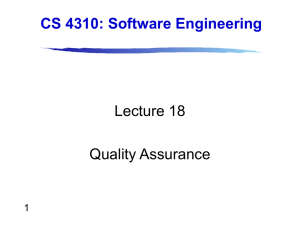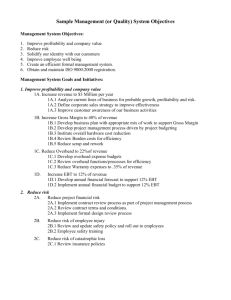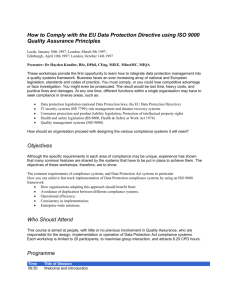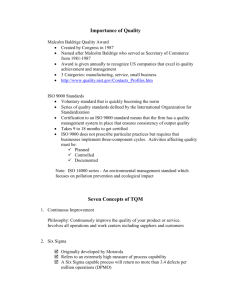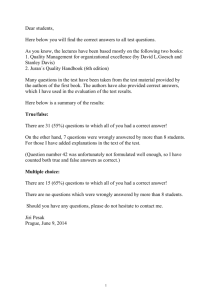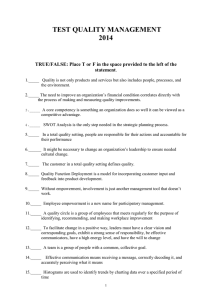Quality Management
advertisement
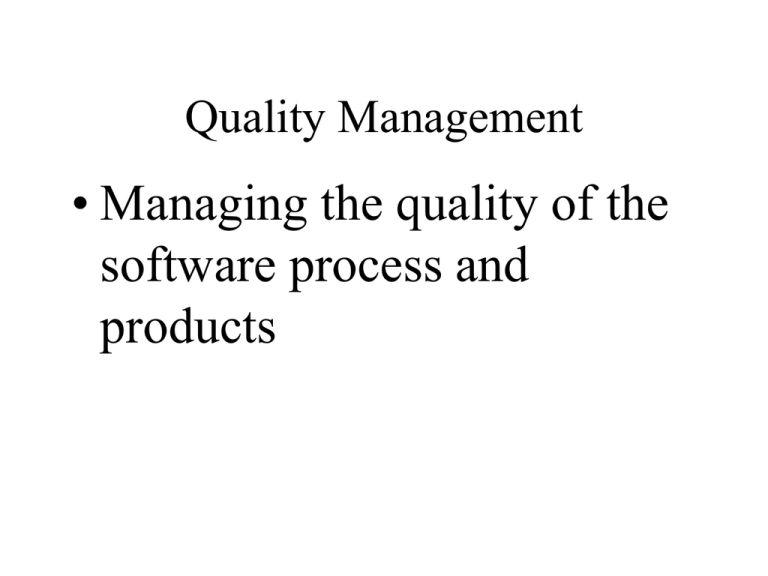
Quality Management • Managing the quality of the software process and products Objectives • To introduce the quality management process and key quality management activities • To explain the role of standards in quality management • To explain the concept of a software metric, predictor metrics and control metrics • To explain how measurement may be used in assessing software quality Software quality management • Concerned with ensuring that the required level of quality is achieved in a software product • Involves defining appropriate quality standards and procedures and ensuring that these are followed • Should aim to develop a ‘quality culture’ where quality is seen as everyone’s responsibility What is quality? • Quality, simplistically, means that a product should meet its specification • This is problematical for software systems – Tension between customer quality requirements (efficiency, reliability, etc.) and developer quality requirements (maintainability, reusability, etc.) – Some quality requirements are difficult to specify in an unambiguous way – Software specifications are usually incomplete and often inconsistent The quality compromise • We cannot wait for specifications to improve before paying attention to quality management • Must put procedures into place to improve quality in spite of imperfect specification • Quality management is therefore not just concerned with reducing defects but also with other product qualities Quality management activities • Quality assurance – Establish organisational procedures and standards for quality • Quality planning – Select applicable procedures and standards for a particular project and modify these as required • Quality control – Ensure that procedures and standards are followed by the software development team • Quality management should be separate from project management to ensure independence ISO 9000 • International set ofstandards for quality management • Applicable to a range of organisations from manufacturing to service industries • ISO 9001 applicable to organisations which design, develop and maintain products • ISO 9001 is a generic model of the quality process Must be instantiated for each organisation ISO 9001 Management responsibility Control of non-conforming products Handling, s torage, packaging and delivery Purchaser-supplied products Process control Ins pection and test equipment Contract review Document control Internal quality audits Servicing Quality s ys tem Des ign control Purchasing Product identification and traceability Ins pection and testing Ins pection and test status Corrective action Quality records Training Statis tical techniques ISO 9000 certification • Quality standards and procedures should be documented in an organisational quality manual • External body may certify that an organisation’s quality manual conforms to ISO 9000 standards • Customers are, increasingly, demanding that suppliers are ISO 9000 certified ISO 9000 and quality management ISO 9000 quality models instantiated as Organization quality manual documents is used to develop Project 1 quality plan Project 2 quality plan instantiated as Project 3 quality plan Supports Organiza tion quality process Project quality mana gement Quality assurance and standards • Standards are the key to effective quality management • They may be international, national, organizational or project standards • Product standards define characteristics that all components should exhibit e.g. a common programming style • Process standards define how the software process should be enacted Importance of standards • Encapsulation of best practice- avoids repetition of past mistakes • Framework for quality assurance process it involves checking standard compliance • Provide continuity - new staff can understand the organisation by understand the standards applied Product and process standards Product s tandards Des ign review form Document naming standards Procedure header format Ada programming s tyle standard Project plan format Change reques t form Process s tandards Des ign review conduct Submiss ion of documents to CM Vers ion release proces s Project plan approval proces s Change control proces s Tes t recording proces s Documentation standards • Particularly important - documents are the tangible manifestation of the software • Documentation process standards – How documents should be developed, validated and maintained • Document standards – Concerned with document contents, structure, and appearance • Document interchange standards – How documents are stored and interchanged between different documentation systems Documentation process Create initial draft Stage 1: Creation Proofread text Stage 2: Polishing Layout text Stage 3: Pr oduction Incorporate review comments Review draft Re-draft document Approved document Produce final draft Check final dr aft Approved document Review layout Produce print masters Print copies Document standards • Document identification standards – How documents are uniquely identified • Document structure standards – Standard structure for project documents • Document presentation standards – Define fonts and styles, use of logos, etc. • Document update standards – Define how changes from previous versions are reflected in a document Quality planning • A quality plan sets out the desired product qualities and how these are assessed ande define the most significant quality attributes • It should define the quality assessment process • It should set out which organisational standards should be applied and, if necessary, define new standards Software quality attributes Safety Security Reliability Resilience Robustnes s Understandability Testability Adaptability Modularity Complexity Portability Usability Reusability Efficiency Learnability Quality control • Checking the software development process to ensure that procedures and standards are being followed • Two approaches to quality control – Quality reviews – Automated software assessment and software measurement Quality reviews • The principal method of validating the quality of a process or of a product • Group examined part or all of a process or system and its documentation to find potential problems • There are different types of review with different objectives – Inspections for defect removal (product) – Reviews for progress assessment(product and process) – Quality reviews (product and standards) Review type Des ign or ins pections Types of review Principal purpose program To detect detailed errors in the design or code and to check whether s tandards have been followed. The review s hou ld be driven by a checklis t of poss ible errors . Progres s reviews To provide information for management about the overall progress of the project. This is both a proces s and a produ ct review and is concerned with costs , plans and schedules. Quality reviews To carry out a technical analysis of produ ct components or documentation to find faults or mismatches between the specification and the design, code or documentation. It may also be concerned with broader quality is sues such as adherence to standards and other quality attributes. Quality reviews • A group of people carefully examine part or all of a software system and its associated documentation. • Code, designs, specifications, test plans, standards, etc. can all be reviewed. • Software or documents may be 'signed off' at a review which signifies that progress to the next development stage has been approved by management. The review process Select review team Complete review forms Arr ange place and time Hold review Distribute documents Key points • Software quality management is concerned with ensuring that software meets its required standards • Quality assurance procedures should be documented in an organisational quality manual • Software standards are an encapsulation of best practice • Reviews are the most widely used approach for assessing software quality Key points • Software measurement gathers information about both the software process and the software product • Product quality metrics should be used to identify potentially problematical components • There are no standardised and universally applicable software metrics
